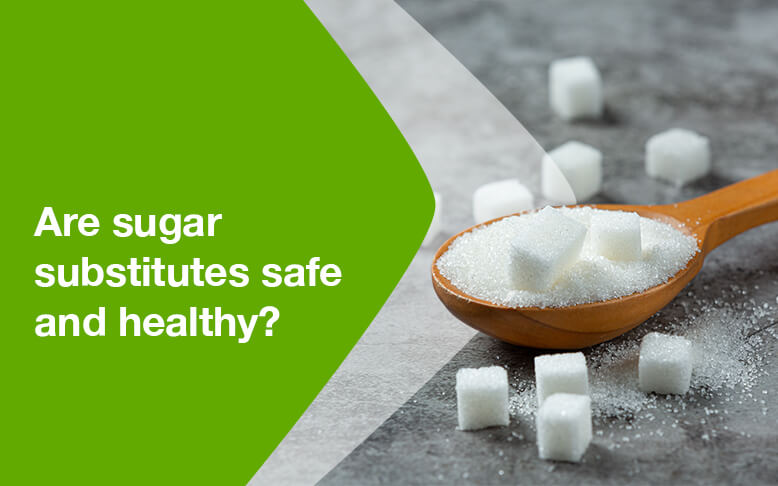Introduction
The word "sugar" has come to have a bad reputation when it comes to nutrition in the modern world. Because of concerns that consuming too much sugar might lead to weight gain, diabetes, and other health issues, many people are looking for ways to reduce their sugar intake without sacrificing their sweet tooth. This has led to increased use of sugar substitutes in various foods and drinks. In 2020, the US Census and Simmons National Survey (NHCS) calculated that 141.18 million Americans used sugar substitutes.1 A cross-sectional study by Jin, Y., et al. (2018) found that a quarter of middle-aged and older South Asians in the US reported using sugar substitutes. Consumption was higher among participants with obesity, hypertension, diabetes, and high cholesterol.2 The intake of diet sodas and sweetener packets was directly associated with their length of stay in the US. According to the Asia Pacific Food Industry (2020), close to nine in ten (87%) consumers are actively taking measures to reduce or consume in moderation products that contain sugar.3
So if your patients are looking to sustain a healthy lifestyle, how do you choose the best sugar substitute when there are so many options available? And how much sugar should they consume? In order to make the best decision, it is important to understand the various sugar substitutes available and their impact on health.
The Difference Between Sugar and Sweeteners
Sugar is available in a variety of forms and from a variety of sources. Granulated sugar, often known as table sugar or white sugar, is the most common kind of sugar consumed by humans. Granulated sugar is refined sugar that is made from sugarcane or sugar beets. It is the type often used in most homes for sweetening applications such as coffee or tea, baking, and cooking. Sucrose, a disaccharide composed of one molecule of glucose and one molecule of fructose, is the main component of granulated sugar. It is widely available, reasonably priced, and used in a wide variety of food and beverage products around the world.
Sugar substitutes came about as a result of scientific research, technical breakthroughs, market demand, and customer preferences. Continuous research and development promote the development of novel sugar substitutes with improved flavor, safety, and usefulness to meet consumers' changing demands and tastes.
Let's learn more about sugar substitutes (alternatives and replacements) used to reduce caloric content in dietary and pharmaceutical products. They would have similar properties to sucrose, such as a similar taste profile, solubility, thermal stability, compatibility with products and applications, ease of production, non-toxicity, and affordability.4
Classifications of Sugar Substitutes
Sweeteners, or sugar substitutes, are classified as nutritive/caloric, low-caloric, and non-nutritive/non-caloric, and can be further subdivided into natural or artificial. Nutritive sugar substitutes (NSS) are caloric sweeteners that can be found naturally in foods like fructose in fruits, added to foods like sucrose in beverages, or as sugar alcohols. They have a chemical structure comparable to sugar but contain fewer calories per gram and do not cause the same rapid rise in blood sugar levels. Some common examples of NSS are Xylitol, Isomalt, Maltitol and Erythritol. Low-calorie sweeteners (LCS), on the other hand, provide a sweet taste with fewer calories due to decreased absorption in the gastrointestinal tract. Aspartame, the only approved low-caloric artificial high-intensity sweetener, contains more than two percent of the calories in an equivalent amount of sugar, while thaumatin and miraculin are examples of LCS natural sweeteners.
In addition, non-nutritive sweeteners (NNS) contain less than two percent of the calories in an equivalent amount of sugar.5 There are also NNS that provide almost no calories when consumed, which is why they are also known as non-caloric sweeteners (NCS). NCS are used to add sweetness to foods and beverages without adding significant calories. They are frequently used by people who are watching their caloric intake, managing their blood sugar levels, or attempting to reduce their sugar consumption in general. Examples of natural NNS include the stevia and luo han guo, while artificial NNS include saccharin, acesulfame-K, sucralose, neotame, and advantame.
Related terms discussed in food science journals are high-potency or high-intensity sweeteners. High-potency sweeteners are artificial or synthetic substances used as sugar substitutes in food and beverages to provide a sweet taste without the added calories and carbohydrates of sugar.6 They are much sweeter than sucrose, so only a tiny amount is needed to achieve the same sweetness level. They are added to sweeten foods and beverages or as an ingredient in sugar-free recipes and products. Other examples of high-potency sweeteners include sucralose and saccharin.
Figure 1. Classification of Sweeteners (Joseph et al., 2019)
As mentioned above, sugar substitutes can be further classified as natural or artificial sweeteners based on composition. Natural sugar substitutes are from plant sources, such as stevia leaves, tropical monk fruit, and thaumatin sweet-amino acid. Artificial sweeteners, on the other hand, are substances that impart sweet taste to food. Most artificial sweeteners are non-nutritive, hence do not add caloric value to food. It may either be synthesized or derived from naturally occurring substances, such as herbs or sugar itself.
Natural sugar substitutes have been studied extensively for their health and safety implications. As an example, a landmark study published in the Journal of Medicinal Food found that stevia consumption helped respondents with high blood pressure lower their blood pressure levels.6 On the other hand, some observed possible adverse effects of using them include allergic reactions, gastrointestinal symptoms like diarrhea and gas, and a negative impact on gut health8,9 It is worthwhile to note that these examples of possible negative effects have been mostly observed from excessive consumption of natural sugar substitutes. Overall, studies show that natural sugar substitutes appear to be beneficial to blood pressure, blood sugar level, and weight management when consumed within recommended limits and in moderation.
The table below can help you learn more about the various types of natural sweeteners that are used to replace sucrose in foods and beverages.
Table 1. Natural Sugar Substitutes (US FDA, 2021 and EFSA, 2019)
| SWEETENER | Regulatory Status | Brand Names | Sweetness compared to sucrose | Acceptable daily intake mg/kg BW | Packets equal to ADI* |
|---|---|---|---|---|---|
Stevia rebaudina (Bertoni) leaves | Non-nutritive sweetener with ≥95% steviol glycosides (GRAS) | Truvia® PureVia® Enliten® | 200-400x | 4* | 9 (300x sucrose) |
Siraitia grosvenorii Swingle (Luo han guo) fruit extract (SGFE) | Non-nutritive sweetener with 25%, 45% or 55% Mogroside V (GRAS) | Nectresse® Monk Fruit in the Raw® PureLo® | 100-250x | Not specified | No data |
Thaumatococcus daniellii Benth (Katemfe fruit) | Nutritive thaumatin sweet-protein (GRAS) | Talin® | 3000x | 0.5- 5.0 | No data |
| Synsepalum dulcificum (Miracle berry) | Nutritive miraculin sweet-protein (GRAS) | MiraBurst® | Modifies taste receptors to make sour foods taste sweet | 0.0007 (except pregnant/ lactating women)** | No data |
*ADI established by the Joint FAO/WHO Expert Committee on Food Additives (JECFA)
**EFSA concludes that dried miracle berry (DMB) is safe for use in food supplements at the maximum intake level of 0.7 g per day for adults, excluding pregnant and lactating women
Since aspartame is sensitive to high temperatures, when heated during baking, it becomes unstable and loses its sweetness. Aspartame has the components aspartic acid, methanol, and phenylalanine. While a relatively new sugar substitute, advantame has a similar chemical form as aspartame. People who restrict their intake of phenylalanine due to phenylketonuria (PKU) must read the nutrition label of food products and beverages. PKU is an inherited disorder characterized by excessive phenylalanine in the blood. Phenylalanine is an essential amino acid from protein-rich foods. It may become toxic to the nervous system if the body lacks the enzyme to convert it into a non-essential amino acid tyrosine, a neurotransmitter that also affects mood and pigmentation.12
Moreover, Acesulfame-K (Ace-K), neotame, and advantame are approved sweeteners and flavor enhancers.13 Take a look at this table to learn more about artificial sweeteners.
Table 2. Artificial Sugar Substitutes* (US FDA, 2018)
| SWEETENER/ (Year of approved use) | Regulatory Status | Brand Names | Sweetness compared to sucrose | Acceptable daily intake mg/kg BW | Packets equal to ADI** |
|---|---|---|---|---|---|
SACCHARIN (1879) | Non-nutritive sweetener in certain foods and additive for specific technological purposes | Sweet and Low® Sweet Twin® Sweet'N Low® Necta Sweet® | 200-700x | 15 | 45 (400x sucrose) |
ASPARTAME (1981) | Low-calorie sweetener and flavor enhancer | Nutrasweet® Equal® Sugar Twin® | 200x | 50 | 75 |
| ACESULFAME-K (1988) | Non-nutritive sweetener and flavor enhancer (except in meat and poultry) | Sweet One® Sunett® | 200x | 15 | 23 |
SUCRALOSE (1998) | Non-nutritive sweetener | Splenda® | 600x | 5 | 23 |
| NEOTAME (2002) | Non-nutritive sweetener and flavor enhancer (except in meat and poultry) | Newtame® | 7,000-13,000x | 0.3 | 23 (10,000x sucrose) |
ADVANTAME (2014) | Non-nutritive sweetener and flavor enhancer (except in meat and poultry) | No brand name | 20,000x | 32.8 | 4,920 |
*Adapted from the US Food and Drug Administration (2018). Additional Information about High-Intensity Sweeteners Permitted for Use in Food.
**Number of Tabletop Sweetener Packets a 60 kg person would need to consume to reach the ADI. Calculations assume a packet of high-intensity sweetener is as sweet as two teaspoons of sugar.
Safety of Sugar Substitutes
While sugar substitutes may help reduce caloric intake for many people, there are controversies that point to their adverse effects, such as headaches, abdominal disturbances, hypoglycemia, and cancer, especially in some people with diabetes and cardiometabolic risks. Most artificial sweeteners contain compounds that are not metabolized in the body, leaving concerns on their toxicity.14
- Headaches
Headache is one of the reported symptoms of acute toxicity for artificial sweeteners such as acesulfame-K, aspartame, and neotame, according to Whitehouse et al. (2008). It was one of the most often reported side effects of aspartame, although research found no link between aspartame and headache.15 Double-blind, controlled trials showed no difference in headache frequency between the experimental and placebo groups16 while another study reported that some people may be more sensitive to aspartame, causing headaches.17
- Mood changes
High intakes (25 mg/kg body weight per day) of aspartame was associated with higher frequency of irritability and depression episodes among college students18 and healthy adults.19 This observation was linked to the alterations in the functions of the brain neurotransmitter along with increased cerebral phenylalanine concentrations. However, limited evidence is available for this claim and there is still a need for further studies.
- Hypoglycemia
According to Arshad et al. (2022), several studies have shown that artificial sweeteners raise insulin levels because the body responds to sugar when the signal “sweet” is received.20 This resulted in hunger and hypoglycemia because the perceived sweetness came from an artificial sweetener and not from sugar. This observation was particularly linked to the stimulation of cephalic phase insulin release (CPIR) that was observed to be apparent after ingesting artificial sweeteners such as saccharin (Just et al., 2008).21 However, upon the review of the European Food Safety Authority (EFSA) Advisory Forum, together with national experts, it has been concluded that data supporting this claim is lacking.22
- Carcinogenic
In animal studies, manifestations of chronic toxicity of sugar substitutes include lymphomas, bladder cancer, thyroid tumors, and weight loss.14 However, a prospective cohort study conducted by the National Institutes of Health and American Association of Retired Persons (2012) showed no association between multiple sugar substitutes and major cancers including colorectal cancer.23
Safety Guidelines for Sugar Consumption
The World Health Organization (WHO) recommends people keep their free sugar intake below 10% of their total energy needs daily, and even lower it to 5% for additional benefits.24
For instance, for an adult with a 2000 calorie requirement, the sugar threshold of 10% is equivalent to 50g of added sugar. Computation: 2000 kcal x 0.10 = 200 kcal 200 kcal ÷ 4 kcal/g = 50g or 10 tsp added sugar per day |
Moreover, it's important to note that sugar is considered a food additive. They are considered as either natural or synthetic substances added to food and beverages during processing or preparation to improve their taste, texture, appearance, shelf life, or safety. Food additives like sugar are regulated by food safety authorities to ensure their safety and appropriate use. For instance, the European Food Safety Authority (EFSA) establishes an acceptable daily intake (ADI) for each food additive or group of additives with similar properties. ADI is the amount of a substance that people can consume daily during their whole life without any appreciable health risk. These are usually expressed in milligrams per kg body weight per day (mg/kg BW/day).27
In addition, the Philippine FDA released a set of guidelines covering sugar substitutes. One of the most recent is the FDA Administrative Order No. 2014-0030-A,28 a directive reiterating the mandatory declaration of the type of sweetener used and its equivalent volume capacity in liters, especially for sweetened beverages in powder form, on the labels of the food products.
The FDA also requires all distributors, traders, and importers to review food additives for safety before they are available on the market. FDA Circular 2021-005 issued the guidelines and procedures for the confirmation of product classification and the type of sweetener/s used in sweetened beverages and products. Manufacturing companies must submit the food additive petition to the agency for approval. An exception is for substances "Generally Recognized As Safe" (GRAS) because those substances are generally recognized by qualified experts as safe under the conditions of intended use and are exempt from the food additive approval process.29 GRAS means food additives are safely consumed without causing harm due to long-term use, but their benefits and effects are to be tested in more clinical trials.
Specific advisories were also issued, including the following:
- FDA Advisory 2013-009 that allowed the use of “Magic Sugar”, which is an artificial non-caloric sweetener chemically known as sodium cyclamate, calcium cyclamate, or cyclamic acid.30 This controversial sweetener was previously banned by the FDA due to the results of several animal studies showing the development of urinary bladder tumors31-34 following consumption of sodium cyclamate. However, with several reviews conducted by the WHO/FAO Joint Expert Committee on Food Additives (JECFA) along with the European Food Safety Authority (EFSA), this sugar substitute had been proven safe and was allowed to be used in the country.
- FDA Advisory 2013-058 approving the safe use of aspartame as a "general purpose sweetener" in specific foods and beverages, with a maximum limit of 100 to 10,000 mg/kg.35
- Bureau of Food and Drugs (BFAD) Circular No. 2006-016 listing the additives, including sweeteners, permitted for use under specified conditions in certain food categories.36 Approved sugar substitutes or sweeteners include Acesulfame Potassium (Acesulfame-K), Alitame, Aspartame, Isomalt, Lactitol, Maltitol and Maltitol Syrup, Mannitol, Saccharin, Sorbitol, Sucralose, Thaumatin, Xylitol, and Neotame, as well as nutritive sweeteners such as lactose and maltose.
Sweeteners have a long history of safety evaluations by key international assessment bodies, such as Joint FAO/WHO Expert Committee for Food Additives - JECFA, Center for Food Safety and Applied Nutrition - CFSAN (FDA) and European Food Safety Authority - EFSA (EU). All legally authorized sweeteners are considered to be safe for consumption under the established maximum use levels in various food categories.
Message to Registered Nutritionist Dietitians
There are numerous studies about sugar substitutes and their health implications, which would be worthwhile to consider before making recommendations about them to your patients/clients. It's important to note that specific recommendations should always be based on an individual's unique health needs, preferences, and circumstances. Collaborating with your patients and taking a holistic approach to their dietary choices can help promote overall health and well-being. Some things to keep in mind:
- Promote moderation: While sugar substitutes can be a useful tool for reducing sugar intake, it's important to emphasize to patients that moderation is key. Excessive consumption is never beneficial to anyone. Encourage patients to use sugar substitutes as part of a balanced diet, rather than as a free pass for unlimited consumption. Just like saltiness, sweetness is an acquired taste. People can learn to use sugar substitutes in smaller amounts and with less frequency, or they can totally omit these food additives from their diet.
- Rely on reputable sources of information: RNDs should review the available evidence on safety and efficacy and verify the sources of information before making their recommendations to their patients.
- Evaluate individual health status: Assess your patient's medical conditions, dietary restrictions, and history before recommending any sugar substitutes. Some sweeteners may not be suitable for certain individuals, such as those with allergies, diabetes, or gastrointestinal sensitivities.
- Stay updated: Nutrition science continues to evolve, so it's important for RNDs to stay updated on the latest research and guidelines related to sugar substitutes. This helps ensure that your recommendations are based on the most current and reliable evidence.
Pro Tip
Be wise about food labels. Sugar-free does not mean zero sugar.


 Encar Ramos-Romano , RND
Encar Ramos-Romano , RND













No comments here yet.